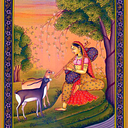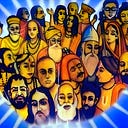The Sant Mat Family Tree: Tracing the Lineage of Masters: Where the Spiritual Path Comes From, by James Bean
There is history-based evidence for a Sant Mat family tree dating back many centuries in India, a lineage of spiritual masters existing prior to the time of the Nineteenth Century guru Sant Tulsi Sahib of Hathras:
1) that are ideological soulmates teaching the familiar form of Sant Mat and Surat Shabd Yoga (Inner Light and Sound Meditation);
2) mention all five of the Five Names (sacred names, simran words used in many forms of contemporary Sant Mat);
3) have a special fondness of the term Kal Niranjan (negative power, an eastern term for the Gnostic demiurge);
4) see the Anurag Sagar (Kabir’s Ocean of Love) as an essential or central scripture defining the Path during this Kali Yuga age;
5) and that have inherited a version of history that says “Sant Dharam Das was the successor of Kabir” (as opposed to someone else).
Solving the Mystery of Sant Tulsi Sahib’s Guru
There was only one contemporary guru who was a living master during the time of Tulsi Sahib that Sant Tulsi Sahib actually named in his hymns and spiritual discourses: Sant Dariya Sahib of Bihar. Sant Dariya and Tulsi’s teachings are almost identical, meeting the criteria of the five points listed above. They both even shared a similar physical appearance and manor of dress. So, as Sant Tulsi Sahib was the one contemporary guru named in the Sar Bachan of Soami Ji, and Baba Devi Sahib’s name appears in the Padavali of Maharshi Mehi, the one conspicuous contemporary master named and quoted by Sant Tulsi Sahib was Sant Dariya Sahib of Bihar. And Sant Dariya Sahib’s guru Sat Saheb was associated with — branched out from — the Sant Dharam Das/Kabir line of gurus embodying those five essential ingredients listed above, which I write about with more details in my booklet on the Origins of Sant Mat, The Five Names, and the Identity of Tulsi Sahib’s Guru. My take is that most likely Sant Tulsi Sahib was initiated by Sant Dariya Sahib of Bihar or one of his successors, thus the Sant Mat family tree, the lineage of masters in earlier centuries comes more clearly into view, and we can know more about where this spiritual path called Sant Mat comes from, this Way of the Saints or Sants, the Mystics of the East.
As I’ve written, I perceive that the lineage goes back to Sant Dharam Das. So I would say an approximate description of the lineage of this Path of the Masters looks something close to this: Satguru Kabir to Sant Dharam Das to Churamani Naam (Dharam Das’s son) to Sat Saheb to Dariya Sahib of Bihar (and/or to one of the immediate successors named by Dariya like Fakkar Das, Basti Das, Tika Das, or Guna Das) to Sant Tulsi Sahib of Hathras, to Sant Girdhari Sahib of Lucknow to his successors including Soamiji Maharaj in Agra… up to the living present.
And while not as conveniently organized into a single easy-to-find volume of banis and bhajans such as the Sikh scriptures (Adi Granth, Gurbani), there are writings from these earlier masters of the Sant Mat family tree that have survived, and that I wish to especially be mindful of and explore on future satsang editions of my podcast, spiritual classics such as: the Kabir Sagar volumes, The Bijak and other Kabir literature, Anurag Sagar, Banis of Sat Saheb, Dariya Sagar, Ratan Sagar, Padma Sagar, the Ghat Ramayan and several others.

